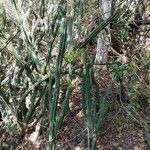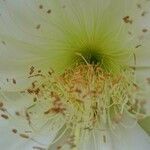Stem-succulent tree, 3-10(-18) m high, often with a short trunk up to 2 m high. Branches 6-8-winged. Areoles with 1-4 or more central spines 10-20(-60) mm long, yellow or brown when young, and (4-)7 or 8(-12) peripheral spines up to 35 mm long, yellow or brown when young. Flowers nocturnal, 210-300 x 150-200 mm. Tepals 80-100 x 20-27 mm, outer tepals greenish, inner tepals white. Stamens oblique in mature flower. Flowering time Nov.-Jan. Fruit red when ripe, succulent berries, ellipsoid, skin smooth, pulp white. Seeds black.
A columnar cactus. It grows 4-12 m tall. The trunk is short. The stems have 8 wings. There are spines in groups along these. The groups are 2-4 cm apart and there are 1-4 central spines and 7-12 spines around these. The flowers occur singly and open at night. The fruit are large and bright red. The pulp is white.
Shrub or tree, up to 5 m high. Ribs on stems 4-10, mostly 5, 40 mm deep; areoles 25-50 mm apart, spines 10-15, yellow to brown, needle-shaped, short, sometimes 20-30 on old branches, some up to 200 mm long, plant sometimes almost spineless. Fruit red. Flowers white.



